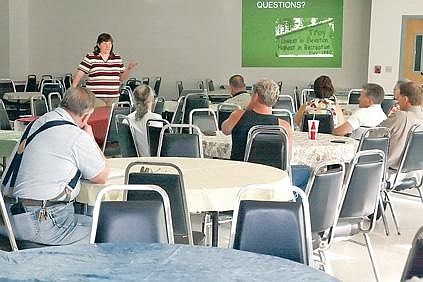Final round of Troy property evaluations to begin
When the Environmental Protection Agency began taking soil samples in December 1999, the primary focus of the cleanup naturally centered on Libby. But the boundaries of the region impacted by asbestos-contaminated vermiculite extended beyond to the neighboring community of Troy.
As the 10th year anniversary of the federal government’s response to the contamination draws near, Troy residents were told Tuesday night that property evaluations are expected to be completed this summer.
The final round of evaluations begin this coming Monday and should wrap up in late August.
“Troy has been able to fall under the Superfund because a lot of people in Troy used to work in the mine,” said the Montana Department of Environmental Quality’s Catherine LeCours, remedial project manager for Troy. “We’re able to extend this type of cleanup and protectiveness in Troy as well.”
Over 2007-08, a positive 94 percent of property owners that responded to access agreements allowed access. A dozen met criteria for removal.
“We started with approximately 1,200 properties … we began in 2007 in population centers and older homes in and around Troy,” LeCours said. “We do a methodical check of all the properties in the operable unit. This is a pretty methodical process of checking every property.”
Montana DEQ is the lead agency in Troy – or Operable Unit 7 as identified in the Superfund process – through a cooperative agreement with the EPA.
In the past, dust samples had been taken in Troy – 1,781 to be exact over the 2007-08 period. But LeCours said those are no longer needed.
“What we learned is that the dust samples don’t tell us anything we don’t already know,” LeCours said. “Now, we do more aggressive looking inside the homes.”
About 40 people attended the Tuesday meeting at the Kootenai Senior Center. LeCours offered a quick history and review of the contamination issue in Libby and Troy.
While the property evaluations wrap up and high-priority sites are cleaned, Troy will see two new components to the process. LeCours said ambient air sampling is scheduled to begin.
“We plan to begin that later this summer,” LeCours said. “We have various stations around the study area. We may contact property owners to see if we can put a box on your property.”
In addition, sampling will include unpaved roads and dirt alleys.
Based on questions and comments from residents and others following the process, it appears that some sense a lesser response when it comes to the cleanup in Troy.
“Quite a few folks brought quite a bit down here,” Dr. Brad Black said of the contaminated vermiculite. “There are individuals who lived here as kids and developed significant diseases.”
In response, LeCours said, “We’re looking at multiple lines of evidence. We have a lot of things to look at and a lot of decisions yet to make.”
Black mentioned the railroad as a huge issue, something echoed by at least one other person at the meeting. The Burlington Northern Santa Fe Railroad is handling cleanup issues on its right-of-way, LeCours said. In the last couple of months, she said the EPA has been working with the railroad on sampling and the expectation is that those efforts will include the Troy area.
“It will get done and hopefully you will find something happening in the next year or so. I understand that’s a question mark out there,” LeCours said.
The railroad is included in Operable Unit 6, which is overseen by the EPA.
“Burlington Northern is very aware of this issue and concerned about the safety of their workers as well,” LeCours said.
An old icehouse on railroad property served as an example of work that has been done. The site was discovered last summer and following a cleanup, LeCours said the railroad quickly responded and within two days had installed steel plates over access points.
The overall theme of the meeting revolved around property reports and LeCours met one-on-one with residents afterward to discuss any concerns.
“We want to identify where Libby vermiculite is in and around Troy,” LeCours said early in the meeting. “We want to determine levels of asbestos in those soil samples. We want to educate you to protect you from having any more exposures until we can get there to get it cleaned up.”
The information center in Troy is located at 303 N. Third St., and is open weekdays from 8 a.m.-4:30 p.m. Those with questions can call 295-9238 or send an e-mail to: info@deqtroyinfo.com .

